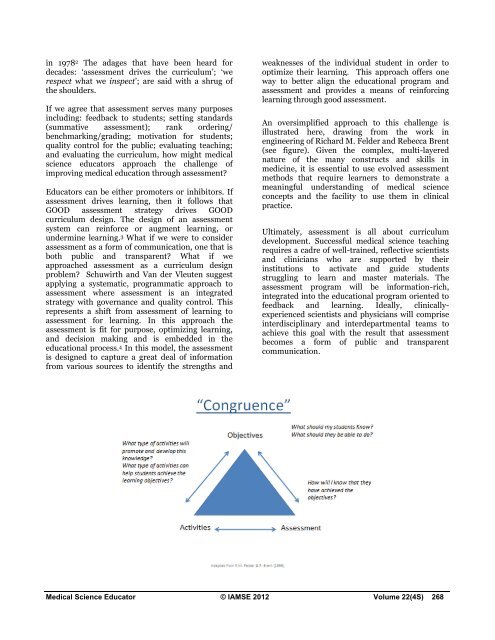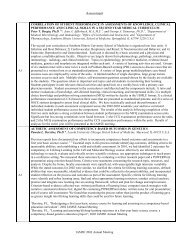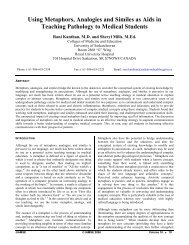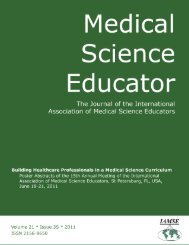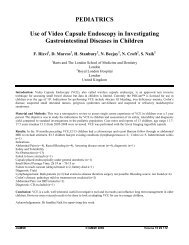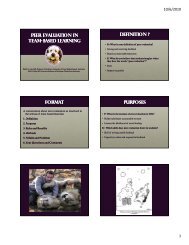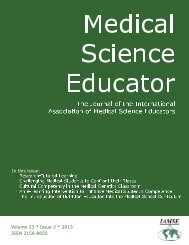Click here to view complete journal in pdf-format - IAMSE
Click here to view complete journal in pdf-format - IAMSE
Click here to view complete journal in pdf-format - IAMSE
You also want an ePaper? Increase the reach of your titles
YUMPU automatically turns print PDFs into web optimized ePapers that Google loves.
<strong>in</strong> 1978 2 The adages that have been heard for<br />
decades: ‘assessment drives the curriculum’; ‘we<br />
respect what we <strong>in</strong>spect’; are said with a shrug of<br />
the shoulders.<br />
If we agree that assessment serves many purposes<br />
<strong>in</strong>clud<strong>in</strong>g: feedback <strong>to</strong> students; sett<strong>in</strong>g standards<br />
(summative assessment); rank order<strong>in</strong>g/<br />
benchmark<strong>in</strong>g/grad<strong>in</strong>g; motivation for students;<br />
quality control for the public; evaluat<strong>in</strong>g teach<strong>in</strong>g;<br />
and evaluat<strong>in</strong>g the curriculum, how might medical<br />
science educa<strong>to</strong>rs approach the challenge of<br />
improv<strong>in</strong>g medical education through assessment?<br />
Educa<strong>to</strong>rs can be either promoters or <strong>in</strong>hibi<strong>to</strong>rs. If<br />
assessment drives learn<strong>in</strong>g, then it follows that<br />
GOOD assessment strategy drives GOOD<br />
curriculum design. The design of an assessment<br />
system can re<strong>in</strong>force or augment learn<strong>in</strong>g, or<br />
underm<strong>in</strong>e learn<strong>in</strong>g. 3 What if we were <strong>to</strong> consider<br />
assessment as a form of communication, one that is<br />
both public and transparent? What if we<br />
approached assessment as a curriculum design<br />
problem? Schuwirth and Van der Vleuten suggest<br />
apply<strong>in</strong>g a systematic, programmatic approach <strong>to</strong><br />
assessment w<strong>here</strong> assessment is an <strong>in</strong>tegrated<br />
strategy with governance and quality control. This<br />
represents a shift from assessment of learn<strong>in</strong>g <strong>to</strong><br />
assessment for learn<strong>in</strong>g. In this approach the<br />
assessment is fit for purpose, optimiz<strong>in</strong>g learn<strong>in</strong>g,<br />
and decision mak<strong>in</strong>g and is embedded <strong>in</strong> the<br />
educational process. 4 In this model, the assessment<br />
is designed <strong>to</strong> capture a great deal of <strong>in</strong><strong>format</strong>ion<br />
from various sources <strong>to</strong> identify the strengths and<br />
weaknesses of the <strong>in</strong>dividual student <strong>in</strong> order <strong>to</strong><br />
optimize their learn<strong>in</strong>g. This approach offers one<br />
way <strong>to</strong> better align the educational program and<br />
assessment and provides a means of re<strong>in</strong>forc<strong>in</strong>g<br />
learn<strong>in</strong>g through good assessment.<br />
An oversimplified approach <strong>to</strong> this challenge is<br />
illustrated <strong>here</strong>, draw<strong>in</strong>g from the work <strong>in</strong><br />
eng<strong>in</strong>eer<strong>in</strong>g of Richard M. Felder and Rebecca Brent<br />
(see figure). Given the complex, multi-layered<br />
nature of the many constructs and skills <strong>in</strong><br />
medic<strong>in</strong>e, it is essential <strong>to</strong> use evolved assessment<br />
methods that require learners <strong>to</strong> demonstrate a<br />
mean<strong>in</strong>gful understand<strong>in</strong>g of medical science<br />
concepts and the facility <strong>to</strong> use them <strong>in</strong> cl<strong>in</strong>ical<br />
practice.<br />
Ultimately, assessment is all about curriculum<br />
development. Successful medical science teach<strong>in</strong>g<br />
requires a cadre of well-tra<strong>in</strong>ed, reflective scientists<br />
and cl<strong>in</strong>icians who are supported by their<br />
<strong>in</strong>stitutions <strong>to</strong> activate and guide students<br />
struggl<strong>in</strong>g <strong>to</strong> learn and master materials. The<br />
assessment program will be <strong>in</strong><strong>format</strong>ion-rich,<br />
<strong>in</strong>tegrated <strong>in</strong><strong>to</strong> the educational program oriented <strong>to</strong><br />
feedback and learn<strong>in</strong>g. Ideally, cl<strong>in</strong>icallyexperienced<br />
scientists and physicians will comprise<br />
<strong>in</strong>terdiscipl<strong>in</strong>ary and <strong>in</strong>terdepartmental teams <strong>to</strong><br />
achieve this goal with the result that assessment<br />
becomes a form of public and transparent<br />
communication.<br />
Medical Science Educa<strong>to</strong>r © <strong>IAMSE</strong> 2012 Volume 22(4S) 268


